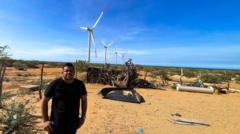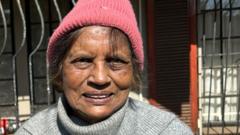The Wayuu community in La Guajira, Colombia, is experiencing a paradox of modernity with the construction of wind farms. While some members appreciate developments like access to clean water and infrastructure improvements, many express deep unease about the cultural and environmental impacts. Divisions within the community further complicate their relationship with energy companies, highlighting the need for clear communication and fair compensation amidst the nation's energy transition.
Tensions Rise as Colombia's Indigenous Communities Confront Wind Farm Development

Tensions Rise as Colombia's Indigenous Communities Confront Wind Farm Development
As Colombia embraces renewable energy through wind farms, the Wayuu indigenous group faces both benefits and grave concerns regarding their lands and culture.
In La Guajira, Colombia, the towering presence of wind turbines stretches toward the Caribbean, representing the country's renewable energy ambitions. Yet for José Luis Iguarán of the Wayuu indigenous group, these monumental structures symbolize a clash between progress and cultural heritage. Despite benefiting from some modern amenities brought by the wind farm Guajira 1, Iguarán and others deeply feel the disruption to their sacred traditions and natural surroundings.
The Wayuu, whose presence spans into Venezuela, have relied on the land's resources for generations. But as wind energy projects multiply—15 more are under construction and potentially more on the horizon—local communities are grappling with the price of these changes. "You wake up and suddenly you no longer see the trees," says Iguarán. The turbines not only alter the landscape but also disturb their spirituality, as dreams hold critical importance within Wayuu culture.
Not everyone shares Iguarán's enthusiasm. Aaron Laguna, a local fisherman, highlights growing divisions within the Wayuu as wind farms raise concerns over compensation and cultural respect. Many feel that negotiations with energy firms lack transparency, leading to disputes and frustration. Joanna Barney, from the think tank Indepaz, underscores that Colombia lacks a robust legal framework to evaluate these projects' true environmental and social ramifications.
The impacts are profound. Recent challenges halted two planned wind farms by Spanish company EDP Renováveis while protests have illuminated discontent within the communities. "We call it the 'wind wars,'" says Barney, pointing to a growing backdrop of tension and violence. The struggles reflect a disconnect between the Wayuu worldview, where winds are treated as sacred beings, and the corporate perspective, which views them merely as a resource.
The situation complicates efforts for energy firms, motivated to cultivate relationships with local communities. AES Colombia is investing heavily in La Guajira, yet its officials recognize that government action is crucial for addressing community grievances. Federico Echavarría, general manager of AES, advocates for collaboration to mitigate conflicts and ensure shared benefits.
Despite promises of clean water and infrastructure improvements, local residents face a heartbreaking irony. Many communities will not enjoy the electricity generated from the wind farms. Local infrastructure remains inadequate, with communities often relying on generators for power—a stark reality amidst plans for a greener future.
As Colombia forges ahead in its energy transition, the challenges faced by the Wayuu remind us that progress does not come without its burden. The promise of wind energy remains overshadowed by a fear that many may still be left in the dark.



















